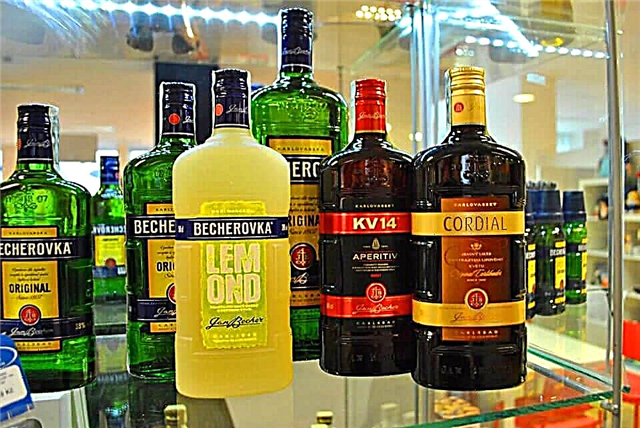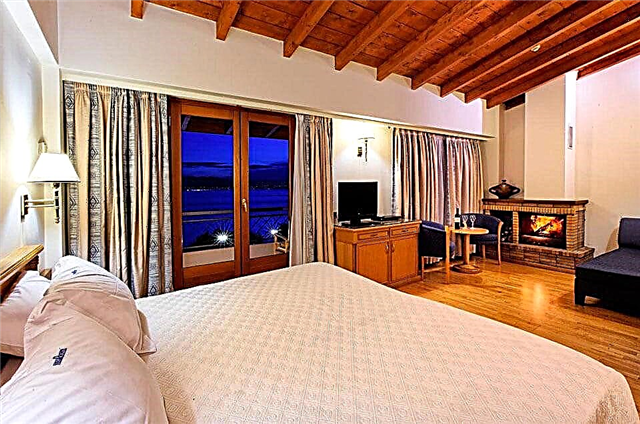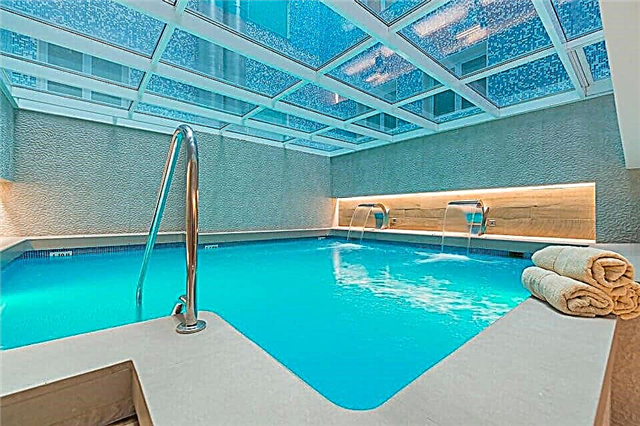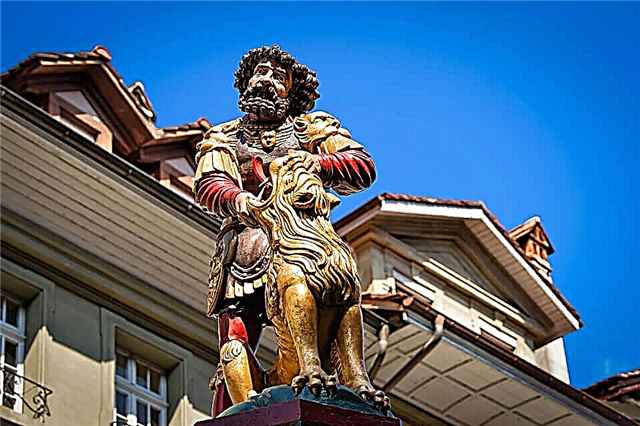The capital of the canton of the same name in Switzerland is considered the fifth largest city in the state, however, in terms of the number of ancient monuments and art objects, it strives not to be inferior to the leaders. It was founded in 1191, since then bears have remained its unchanged symbols, talismans, and business cards. Images of clubfoot are found here at every step: in the interiors and exteriors of houses, pastry shops and restaurants, parks and museums.
Bern's main attractions are located in the Old Town. The capital of the canton attracts lovers of active rest and silence, respectable restaurants and democratic picnics in nature. The city is famous for its private collections of antiques. Its museum expositions are distinguished by thematic variety. The number of cultural objects in the canton and its capital is constantly increasing, which is largely due to the local authorities.
Berne cathedral

The temple is called the standard of Gothic, however, elements of the late Renaissance are also noticeable in its interior. The Protestant Cathedral is the tallest in the confederation in comparison with similar buildings. Its bell tower is over 100 meters high. The weight of the main bell of the temple: 10 tons. Previously, there was a chapel and a church on the site of the building. The construction of the cathedral began in 1421 and was completed at the end of the 19th century, which, of course, affected its external and internal decoration.
The interior of the temple is strict and ascetic. Its main relics are colored stained-glass windows from the 15th century and wooden church furniture from the 16th century. The main motives of the images, elements of the decoration of the temple: the short duration of human life, the equality of all people before death. These themes are also dedicated to the world famous bas-reliefs located at the entrance to the building, where 47 large and 170 small statues remind of the Last Judgment.
Church of St. Peter and Paul

The Catholic Church was built in the second half of the 19th century. When you look at it, you get the feeling that a time machine has transferred part of a quarter of a Swiss city to medieval France. The exterior of the temple intertwined two styles: Romanesque and early Gothic. The dominant religion in this region of Switzerland is Protestantism. The local Catholic community did everything possible to make the new church the pride of the city.
There are 3 bells on the belfry of the church, each of them has a special sound. In the temple you can see colored stained-glass windows, original choir paintings. Some of the elements of its decor were created in the 20th century according to the canons of Art Nouveau, which adds a touch of laconicism to the interior. The church is open to the public; an organ made more than 130 years ago is played in it during services.
Church of the Holy Spirit

The temple is considered Protestant. However, its history and activities are associated with the Catholic Order of the Hospitallers, therefore its main mission remains to care for the sick and the poor. The architecture of the church is distinguished by its grace. The building was erected according to the canons of the Baroque, but its interior decoration is very strict and fully corresponds to the spirit of Protestantism.
Since 1729, services have been constantly held in the church. The church plays the role of a cultural center: it hosts excursions, concerts of sacred music. Notable landmark of the building: 14 sandstone columns. Believers consider these stone elements to be healing. Sandstone has a beneficial effect on the work of muscles, the musculoskeletal system. Not surprisingly, after visiting the church, many feel refreshed, vigorous, full of energy.
Albert Einstein House Museum

The great physicist lived in the house for 2 years with his second wife. Einstein's first son was born in the building. Nowadays, all 2 floors of the house have become a museum dedicated to the genius and his family. It is here that the annual presentation of the Einstein medal takes place, world-famous scientists conduct public lectures on physics, astronomy, and computer technology.
The genius's apartment fully recreates the atmosphere of the early 20th century, when an unknown 26-year-old patent office employee created the theory of relativity, which turned the usual view of people about the world upside down. Most of the interior items were in the house at that time: a spiral staircase, a desk, a clock, a sideboard, a sofa ... Exhibition halls occupy the upper floor of the building. In these rooms you can see a collection of Einstein's works and a documentary about him.
Berengraben

The bear is not only a symbol of Russia. In Switzerland, in every locality there are sights associated with clubfoot. Berengraben is an artificial bear ditch. Previously, there were wild animals in it. In the last century, the Potapychas were moved to a nearby park. Barengraben today is primarily associated with it among residents and guests of the city.
In the park, you can see bear cubs and adult bears (including those brought from Russia). It has created conditions close to the natural habitat of animals, and the old site has been turned into an open-air museum. The ancient structure is visited by those who want to feel the spirit of medieval Europe. The height of the stone walls here is very impressive; it is impossible to get out of the pit without assistance. It is easy to imagine the risk the daredevils descended into it.
Old city

Most of the buildings in this area of Bern were built in the 13th – 14th centuries. The first buildings appeared here about 1000 years ago, and settlements were on the territory already in the Neolithic era. The most famous buildings of the Old Town: the cathedral, the medieval clock tower, the active bridge. There are over 100 fountains in this area, each of them is a real work of art.
Walking around the Old Town reminds of the times when it turned into an impregnable fortress, but the ancient buildings look very cozy. In medieval houses there are restaurants, cafes, souvenir shops, pastry shops. In the Old Town you can taste local cuisine, meet European, American, Asian film stars who adore the Bernese authentic atmosphere.
Park Gurten

Height of Mount Gurten: over 800 meters. The park of the same name occupies its top and slopes. Sledges, skis, bicycles, roller skates are the main means of transportation here. The access to the mountain is closed for cars. A funicular runs from the foot to the top and back. On the territory of the park there is a miniature railway for children, there is a yak pen where you can admire the animals in their natural habitat.
The infrastructure of the recreation area includes a hotel, a concert hall, a swimming pool. Its viewing platforms are always popular, from where the peaks of the neighboring mountains and Bern are visible. One of the main tasks of the park: promoting the culture of the peoples inhabiting Switzerland. There are numerous cafes and restaurants serving national cuisine. In the summer, Gurten turns into a venue for music festivals. Exhibitions and conferences are held on its territory all year round.
Cytglogg

The clock tower is located in the old part of the city. Souvenirs with her image are considered the most popular in Europe. An amazing structure was erected in the XIII century exclusively for the defense of the city. The clock on the tower appeared 200 years later (when it had already been a city prison). Since that time, sculptures "come to life" here every hour for 4 minutes to remind of the inexorable run of time.
Ancient deities, heroes of folk tales, animals (including the bear - the symbol of the city) move rhythmically. The chime of the clock is heard every 60 and 15 minutes. An important part of the ancient mechanism is the astrolabe, thanks to which you can find out the exact phase of the moon, the zodiac sign that patronizes the lunar day.The watch allows you to feel in the Middle Ages, when people believed: the Earth is in the center of the Universe, and the Sun, planets and constellations revolve around it.
Federal palace

This building houses the Swiss government, which does not prevent it from being a popular tourist destination. The only thing: there may be problems with the resolution for photo and video filming. This is not connected with the secrecy regime, but with the presence of valuable exhibits on the territory of the palace. For tourists, it has a special gallery where you can watch parliamentary sessions. The building was erected at the end of the 19th - beginning of the 20th century.
Local materials, marble, precious woods were used in its decoration. The pride of the palace are colored stained glass windows, wall and ceiling mosaics, glass decor elements, wooden carved decorations, numerous bronze statues. Among his rarities: a panel depicting the main Christian virtues and two bronze bears holding the state emblem in their paws.
Paul Klee Center

Named in honor of the famous artist, whose works became the basis of the funds of the art object. The founders of the center - members of the Klee family - donated the master's works to the city. The artist's surname is iconic for the European avant-garde. His work is multifaceted: it combines the features of constructivism and expressionism, the desire to stand out from the crowd and completely dissolve in the beauty of nature.
The building of the center is quite unusual: most of its exhibition halls are located underground. The funds contain about 4000 works of the artist. The expositions are constantly updated. A few visits a year is enough to see most of his collection. The center is a functioning concert venue. Children's cultural programs are an important part of his work.
Historical Museum

It is considered the second largest in the state, where various exhibitions traditionally occupy huge areas. It leads its history from the antique museum, whose small collection became the starting point for creating a collection of 500 thousand antiques. Collections were replenished in different ways. Burgundy tapestries, for which many European tourists come to Bern, were captured as a trophy of war in the 15th century.
The famous traveler Henri Moser presented oriental antiquities to the city. Today, valuable exhibits are stored in a three-story building, they give visitors an idea of the life of the city in different historical eras. The complex is very international: it hosts exhibitions dedicated to the life, work, activities of famous Swiss and residents of other states. Its halls display rarities dedicated to the history of Asia, Africa, Australia, America.
Rose garden

The famous landscape monument dates back to the 18th century. At the moment, over 200 elite varieties of roses of all kinds of colors and shades are growing on its territory. The park was opened on the site of an abandoned city cemetery, whose site was turned into an oasis of beauty by the forces of the Bernese.
An artificial pond is located in the center of the recreational area. The park is famous not only for roses, but also for its collections of irises and rhododendrons. There are no noisy crowds of tourists in it. Citizens and guests of the city come to the garden (which is open around the clock) to take a break from the hustle and bustle, sit on the benches, and admire the magnificent views of Bern from the height of the hill.
Art Museum

It is considered the oldest in Switzerland. It belongs to the state. The history of his first collections, whose objects can still be seen today, began in the 19th century with copies of antique sculptures. Gradually, they began to add drawings, watercolors by different artists, and in two centuries a collection was collected, which has no equal in the world.
The museum contains works of Italian masters of the Renaissance, it contains many masterpieces of art that previously belonged to the European imperial, royal, and princely dynasties. The collection is constantly updated. An important part of it is the work of Dali, Picasso, Modigliani, Cezanne, Kandinsky. In addition to paintings, sculptures, watercolors, graphics, a lot of unique photographic works are presented here.
Fountain "Eater of children"

The architectural monument is a frightening sight and, frankly, the little city dwellers do not like it. The Bernese themselves find it difficult to say exactly which cannibal is depicted on the fountain: either the ancient god Kronos dressed in local clothes, or a cardinal who has lost several wars, or the brother of one of the dukes, who surpassed the famous bloody Lady Bathory in his cruelty.
For more than 400 years, parents have brought their children to this fountain to explain what punishment awaits disobedient children. Today, services that protect the rights of young citizens in the state will not allow adults to do this. And the fountain still works in the city as a reminder of the Middle Ages and the mystery of its main sculpture.
Fountain "Samson"

Initially, the fountain was made of wood, then all of its elements were replaced with those made of stone. The building was erected in the 16th century; the butchers' guild donated funds for the appearance of a new attraction in the city. The fountain is the personification of power for the people of Bernese. Samson breaks the lion's mouth, thereby symbolizing the strength of his spirit, and not just excellent physical data.
The sculpture of the biblical character is placed on a pedestal, around which there is a stone pool with the purest drinking water. The figure of Samson is an exact copy of the original medieval sculpture. The second is now kept in the Berne Historical Museum due to the fact that in quiet Switzerland there is a problem of protecting monuments from the encroachments of vandals.
Fountain "Justice"

The fountain was built in the 16th century. "Justice" differs from similar monuments of antiquity in that it looks today as on the day of its opening. More precisely: after replacing wooden elements with stone ones. "Justice" has never been moved to another place or rebuilt to suit the new political realities. The fountain was destroyed by vandals, after which the Bernese people painstakingly restored the building piece by piece.
The central figure of the architectural composition: the goddess of justice located on a pedestal (the original of the sculpture is kept in the historical museum). Her clothes are reminiscent of women's fashion of the early Middle Ages, Renaissance and antiquity at the same time. The golden armor of Justice shines in the sun. A bandage is placed on the eyes of the goddess. In the hands of Justice holds a sword, at her feet are busts of earthly rulers. The sculptural composition is surrounded by a pool with the purest artesian water.
Alpine museum

Opened at the beginning of the last century, its collection is distinguished by its scale and versatility. The building for funds and expositions was built a little later (in the 30s). Today it is recognized as a cultural monument of national importance. The collections include about 200 thousand items, including antiques, photographs, prints, art canvases. All of its exhibits are dedicated to the Swiss Alps and the work of famous people who glorified the beauty of the mountains in their works.
In the museum you can learn a lot about the geological structure and fauna of the Alps. He is the owner of the world's largest collection of geological volumetric maps. There is a cinema on the territory of the building, where a documentary film about women climbers is often shown. The museum offers special children's interactive programs for young visitors. It houses a gift shop and a local restaurant.
Kleine Schanze Park

A respectable park in the 80s of the last century was a very hot place, but the city authorities managed to put things in order here. Previously, there were military structures on this territory that protected the city from sudden enemy attacks.The fortifications are partially preserved; in their place there is a popular observation deck, from where a stunning view of Bern and the Alps opens up.
The park is cozy at any time of the year. Its main attractions: lakes, numerous alleys. Kleine Schanze is preferred by lovers of silence and walking, but it regularly turns into a huge concert venue where Swiss music sounds. There are playgrounds for young visitors in the park.
Botanical Garden

The history of the garden dates back to the 18th century, and local residents claim that it is at least 200 years older. If you believe the documents: the landscape monument of the same name appeared only at the end of the 19th century. The Swiss are famous for their accuracy and punctuality, but the frequent “moving” of the garden clearly confused the Bernese. An important point: entry with children is prohibited on the territory of many garden greenhouses. This is due to the fact that they contain very rare plants.
Today the garden covers 2 hectares, where 7 huge greenhouses operate. Its collection numbers about 6 thousand plant species, including exotic ones. A special section of the park is dedicated to representatives of the flora of the Alps. For fans of tropical cultures, the Palm House is open here. In the garden, you can watch the work of scientists and ecologists.
Tram museum

In size, it is clearly inferior to the Zurich one, but the Bernese consider their museum to be the most interesting in Switzerland. The main value of the collection: unique photo collections. Among its exhibits there are equipment, trams, but it is the photographs that capture the history of transport development that attract visitors here.
The most valuable items in the collection date back to the 60s of the last century. The museum has its own transport, including two operating trams. In the new century, significant changes took place in his collection: it was replenished with buses, cars. There is a club of lovers of old technology.
Delhölzli Zoo

The zoo is small but has a cozy atmosphere. It has created comfortable living conditions for representatives of the animal world. A favorite walking spot for visitors to the zoo is the pond, where you can admire the flamingos. The spacious enclosures are inhabited by lynxes, bears, seals, wolves, musk oxen, bison, and reindeer. Monkeys are recognized as real favorites of local children.
Crocodiles also feel quite comfortable in alpine conditions. The zoo has all the conditions for family recreation, its infrastructure is not limited only to the playground. A separate part of the territory is intended for picnics. The program of the zoo includes group thematic excursions for children and adults.
Natural History Museum

Founded in 1832. Over 100 thousand people visit it annually. His dioramas are known far beyond Switzerland. Collections of skeletons of domestic and wild animals are considered the largest in the world. Here you can learn a lot about the development of biological species on Earth, see gold bars, rare minerals found in the Alps.
The collection of stuffed animals is considered one of the best in the Old and New Worlds. It is here that you can see the figure of the famous dog Barry, who saved over 40 people in the Alps. The section on sexuality provides visual information about the reproduction of representatives of the animal world. A special place among the exhibits is devoted to death. Among the rarities there is a mask specially made for the popular science fiction movie Alien.
Elfenau

The history of the famous estate is closely connected with Russia. The park belonged to the representatives of the Romanov dynasty. It is perfectly preserved, but lovers of antiquity still gruntly notice that Elfenau looked better in the 19th century. The park is named after the elves. Today, it houses a municipal nursery, whose greenhouses are filled with flowers from all over the world.
The house, which is the heart of the protected area, was built near the river bay. The building, erected in the Baroque style, is in perfect harmony with the beauty of the surrounding nature. In it you can see the original things of the Grand Duchess Anna Fyodorovna. Elfenau is famous for its water sources and gazebos. One of its famous attractions: the artificial romantic date grotto where the waterfall is located.
Museum of Communication

The main theme of all his exhibitions: types of communication and its role in the human world. It was discovered in the last century, but its history began earlier. The start of the new project was a collection of postage stamps and documents that tell about the history of the formation of the Swiss state postal service. The first "place of residence" of the museum was the post office, then a separate building was given to its expositions.
Today, its halls display exhibits dedicated to the development of the Internet and computer technologies. In the halls one can see giant computers and miniature tablets, various media equipment. The exhibition space is about 600 square meters. As the locals joke with pride: more than half of them are engaged in unique Swiss brands.
Prison tower

Once the building was part of a huge fortress wall, whose fragments can still be seen in the city today. If we think logically: the building is most correctly called a gate-tower. It combines the functions of both types of structures. On its façade there is a famous clock: "The Majesty of Bern". The tower got its gloomy name due to the fact that in the last century there was a prison in it, but earlier the gates performed mainly a defensive role.
Today, the building houses one of the famous Swiss museums. It is also a popular venue for public events. Museum expositions, housed in the tower, are dedicated to the development of culture and business in the city. It is noteworthy that in the building there was still a place for a judicial archive and ... storage of wine. The drink is for sale: it can be ordered from restaurants located near the tower.











